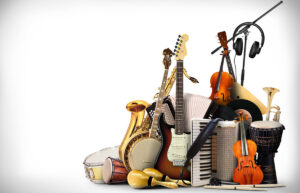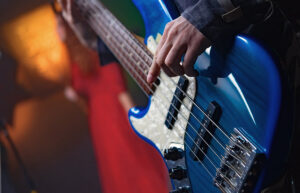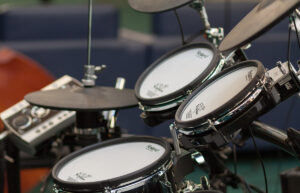Types of Drums in a Marching Band: Exploring the Rhythms

In this comprehensive guide, we’ll explore the different types of drums in a marching band that contribute to the pulse and energy of a marching band. From the iconic snare drum to the melodic nuances of tenor drums, we’ll discuss each drum’s unique characteristics and roles.
Welcome to TheDemoStop, now join the community!
Connect with artists, fans and producers around the world.
Types of drums in a marching band
Marching bands are vibrant and embody musical and visual artistry, captivating audiences with precision, rhythm, and dynamic performances. At the heart of this rhythmic spectacle lies the diverse array of drums comprising the marching band percussion instruments.
Drums are pivotal in a marching band, as the rhythmic heartbeat propels the ensemble forward. Each drum plays a crucial role in shaping the sound and character of the marching band. Drums add flair, dynamics, and visual interest to the band performance. They contribute to the ensemble’s precision and play a vital role in creating an engaging and cohesive musical experience.
There are four drums in the marching band. The marching band drums’ names are Snare, Tenor, Bass, and Timbani. This blog will discuss the types of drums in a marching band and the characteristics of these drums in detail.
Snare drums

Snare drums serve as the rhythmic centerpiece in a marching band. They mainly contribute to the sharp, staccato sound that defines numerous drum beats. Additionally, snare drums play a crucial role in adding accents, executing rolls, and incorporating various dynamic elements, making them versatile contributors to a drum kit’s overall range of sounds.
The snare drum is like the heartbeat of the percussion family, setting the rhythm and adding that crisp, distinctive sound to any musical ensemble. Let’s break down the key aspects:
- Material: Snare drums typically have a shell of wood (maple, birch, mahogany), metal, or a combination.
- Components: A typical snare drum consists of a cylindrical shell, two drumheads (batter head on top and resonant head on the bottom), snares (wires or cords stretched across the deep head), and a set of throw-off and strainer mechanisms.
- Hardware: Snare drum hardware includes tension rods, lugs, rims, and a throw-off/strainer mechanism. Tension rods tighten the drumheads, while the throw-off allows the drummer to engage or disengage the snare wires.
- Size: Snare drums come in various sizes, but a standard diameter is around 14 inches, and the depth can range from 5 to 8 inches.
- Weight: it depends on the materials used. A typical snare drum might weigh anywhere from 10 to 20 pounds.
- Tuning: Tuning a snare drum involves adjusting the tension of the drumheads. Drummers can achieve a wide range of tones by tweaking the tension of the batter and resonant heads.
- Playing techniques: Drummers use various techniques on the bass drum, including single strokes, double strokes, and heel-toe techniques for rapid and controlled playing. The beater can be played in the center for a full, deep sound or near the drumhead edge for a punchier attack.
- Role in marching band: The bass drum provides a marching band’s low-end foundation and rhythmic pulse. It helps anchor the ensemble’s tempo and provides the fundamental beats in cadences and marching patterns. Its deep and resonant sound adds a powerful and authoritative element to the ensemble’s sound.
Tenor drums

Tenors—the heartbeat of the drumline! Tenor drums are a set of multiple toms arranged in a single frame, typically worn by the drummer using a harness. This setup allows for various pitches and tones within one instrument, creating a dynamic and impactful presence in marching bands, drum corps, and other percussion ensembles.
There are three types of tenors: Single, quads, or qunits. These drums are not just about the sound—they’re a visual spectacle, contributing to the excitement and energy of a performance.
Single tenors
Single tenors or single-headed toms, are a distinctive and versatile component of the percussion section in marching bands and drum corps. Unlike multiple-tom setups, single tenors feature a single drum, providing a focused and impactful sound that adds rhythm and flair to the ensemble.
- Materia: Single tenors are commonly constructed with birch, maple, or fiberglass shells. The choice of material influences the drum’s resonance, durability, and tonal characteristics.
- Components: The single tenor consists of a single drum mounted on a frame. The drummer often wears it using a harness, allowing for mobility and ease of playing. Some setups may also include a rim to provide additional playing options.
- Size: A single tenor drum can vary, but a standard diameter falls 12 to 14 inches. The drum’s depth is typically around 8 to 10 inches.
- Weight: A single tenor drum can weigh approximately 10 to 20 pounds.
- Tuning: The drumhead of a single tenor can be individually adjusted to achieve specific pitches. Tuning adjustments are made by tightening or loosening the drumhead, allowing the drummer to create a desired tonal balance.
- Hardware: Single tenors are typically mounted on a frame, and the hardware includes brackets and a support system for stability. The frame is often attached to a harness worn by the drummer, distributing the weight of the drum and allowing for comfortable and agile movement.
- Playing techniques: Drummers use various playing techniques on single tenors, including single strokes, double strokes, and rudiments. The setup allows the drummer to produce expressive and dynamic playing, with opportunities for creative fills and accents.
- Role in marching band: Single tenors provide rhythmic support and visual impact. They are often featured in drumline cadences and contribute to marching band performances’ overall energy and excitement. Single tenors’ agility and focused sound are key to creating dynamic and engaging drumline arrangements.
Welcome to TheDemoStop, now join the community!
Connect with artists, fans and producers around the world.
Quads
Quads, short for quadruple drums, consists of four drums of varying sizes mounted on a common frame. The player uses mallets or sticks to create intricate rhythms. They are a prominent and dynamic component of the percussion section in marching bands and drum corps, providing a versatile range of tones that enhances the overall rhythmic complexity of the ensemble.
- Materia: Quads are typically constructed with birch, maple, or fiberglass shells.
- Components: A set of quads consists of four individual tom-toms, each with its drumhead and shell, mounted on a frame. The drums are arranged in a specific configuration for easy and efficient playing.
- Size: The size of quad drums can vary, but a standard diameter for each drum might be around 6 to 12 inches. The depth of the drums can range from 6 to 8 inches.
- Weight: A set of quads weighs between 30 and 50 pounds or more.
- Tuning: Each drum in the quad set can be individually adjusted to create distinct pitches. Tuning adjustments are made by tightening or loosening the drumheads, allowing flexibility in achieving the desired tonal balance.
- Hardware: Quads are mounted on a frame, and the hardware includes brackets and a support system that allows for precise arrangement and stability. The frame is often attached to a harness worn by the drummer for ease of movement and to distribute the weight of the drums.
- Playing techniques: Drummers employ various techniques on quad toms, including single strokes, double strokes, and intricate rudiments. The setup allows for dynamic and expressive playing, with the ability to create complex rhythmic patterns and accents.
- Role in marching band: Quads contribute to the musical expression. They are often featured in drumline cadences, adding depth to the ensemble’s sound during marching performances. The visually impressive and sonically versatile nature of quads makes them a key component in both the musical and visual aspects of marching band shows.
Quints/Squints
Like quads, quints, short for quintuplet toms, are a set of five tom-toms arranged in a single frame. They are a distinctive and visually striking component of the percussion section in marching bands and drum corps, adding sonic depth and rhythmic complexity to the ensemble’s sound.
- Materia: The shells of quint toms are commonly made from materials like birch, maple, or fiberglass.
- Components: Quints typically consist of five tom-toms mounted on a sturdy frame. Each tom-tom is a separate drum, allowing for a range of pitches within the set.
- Size: Common sizes for quint toms are 6″, 8″, 10″, 12″, and 13″. The depth of the drums can range from 6 to 8 inches.
- Weight: The weight of a set of quints depends on factors such as the size of the drums, the materials used, and the design of the carrier or harness system. As a rough estimate, quints may weigh between 40 to 60 pounds or more.
- Tuning: Each drum in the quint set can be individually tuned to achieve specific pitches. Tuning adjustments are made by tensioning or loosening the drumheads.
- Hardware: The hardware for quint toms includes mounting brackets and a frame that holds the drums in a specific arrangement. The frame is often attached to a harness worn by the drummer to provide stability and ease of movement.
- Playing techniques: Drummers use traditional drumming techniques on quint toms, including single strokes, double strokes, and rolls. The unique setup of quint toms allows for intricate and dynamic playing, adding flair and complexity to marching band performances.
- Role in marching band: Quint toms contribute to the texture of the ensemble. They often accentuate specific musical phrases and add rhythmic complexity to marching band arrangements. The visual impact of the quint setup, combined with its versatile tonal range, makes it a standout feature in both musical and visual aspects of the performance.
Bass drum

Bass drums in a marching band provide the foundation of the band’s rhythm. The big drum in the marching band has deep, resonant tones that contribute to the power and impact of the percussion section.
- Materia: The bass drum shells are made of fiberglass in a marching band.
- Components: A typical bass drum comprises a large cylindrical shell, two drumheads (batter head on the front and resonant head on the back), tension rods, and lugs. Some bass drums have a hoop-mounted or in-shell suspension system to enhance resonance.
- Size: The standard diameter is often around 22 inches, but they can range from 18 to 26 inches or even larger. The drum’s depth can also vary, with common sizes falling between 14 to 18 inches.
- Weight: Due to their size, bass drums are considerably heavier than other drum components, often weighing 20 to 30 pounds or more.
- Tuning: Tuning the bass drum involves adjusting the tension of both the batter and resonant heads. While the bass drum is often tuned lower than other drums in a kit, the specific tuning depends on the desired sound and the musical context.
- Hardware: Bass drum hardware includes tension rods, lugs, and sometimes a tom mount for attaching toms to the bass drum. In marching bands, a harness or carrier system is used to support the weight of the bass drum for mobility.
- Playing techniques: Drummers use various techniques on the bass drum, including single strokes, double strokes, and heel-toe techniques for rapid and controlled playing. The beater can be played in the center for a full, deep sound or near the drumhead edge for a punchier attack.
The bass drum can also be “dampened” or “muffled” using various techniques, such as placing a pillow or a blanket inside the drum. This helps control the sustain and resonance, allowing drummers to achieve the desired sound for different musical contexts.
- Role in marching band: The bass drum helps anchor the ensemble’s tempo and provides the fundamental beats in cadences and marching patterns. The bass drum is crucial to the impact and energy of the marching band’s performance. Its sound adds a powerful and authoritative element to the ensemble’s sound.
Welcome to TheDemoStop, now join the community!
Connect with artists, fans and producers around the world.
Timpani

Timpani, or kettle drums, are large, marching band drumline instruments dating back centuries. They are characterized by hemispherical copper or fiberglass bowls played with mallets.
- Materia: Traditional timpani has copper bowls, although more modern versions can use fiberglass.
- Components: Each timpano (singular of timpani) consists of a bowl, a pedal mechanism for tuning, a set of tuning gauges, and a set of mallets.
- Size: Timpani come in various sizes, but a standard set might have drums with diameters ranging from 23 to 32 inches. The
- Weight: The weight of a timpani can vary depending on its size and materials, but a typical pedal timpani might weigh anywhere from 25 to 50 pounds or more.
- Tuning: Timpanists use a pedal mechanism to change the tension of the drumhead and, therefore, the pitch. The pedal allows for precise tuning adjustments while playing, making the timpani one of the few orchestral instruments capable of real-time pitch changes.
- Hardware: The pedal mechanism is a crucial part of timpani hardware. It allows the player to control the tension of the drumhead, and thus the pitch, using a foot pedal. Tuning gauges on each drum assist the player in achieving accurate and consistent pitches.
- Playing techniques: Timpanists employ mallets to strike the drumhead, employing various playing techniques. Different parts of the mallets can produce different tones, and techniques such as rolls and glissandi are frequently used. Proficient timpanists can craft expressive and melodic passages on these drums.
- Role in marching band: Timpani are not typically part of a traditional marching band due to their size and weight, but some modern ensembles may incorporate electronic or lightweight versions. Timpani is crucial in providing tonal depth, rhythmic precision, and dynamic expression.
Summary
Marching band drums are designed for mobility and precision in outdoor performances. They include snare drums, single tenors, quads, quints/squints, and bass drums. The various types of drums in a marching band contribute to the ensemble’s diverse soundscape:
- Snare Drums: Known for their sharp and crisp sound, snare drums are the backbone of the rhythm section, providing a foundational beat for the entire band.
- Tenor Drums
- Single Tenors: Operating as a solo instrument, single tenor drums cover a range of pitches, adding versatility to the ensemble.
- Quads: Comprising four drums in harmony, quads create dynamic patterns, enhancing the rhythmic complexity of the marching band.
- Quints/Squints: Utilizing five drums, these drums contribute to intricate and melodic beats, expanding the tonal range of the percussion section.
- Bass Drum: Often referred to as the “heartbeat” of the band, bass drums provide depth and power to the overall musical composition.
- Timpani: Tunable kettle drums or timpani contribute gravitas to the marching band, adding orchestral richness and melodic depth to the ensemble’s performance.
FAQs
What are the drums called in a marching band?
The three types of drums in a marching band include Snare drums, Bass drums, Timpani, and Tenors.
What are the main types of drums?
- Snare drum: Worn at the waist of the drummer and played with drumsticks, the snare drum provides sharp and rhythmic patterns, serving as the backbone of the marching band’s percussion section.
- Tenor drums (or Quads): Also known as quads or tom-toms, tenor drums consist of multiple mounted drums of different sizes attached to a single carrier. The drummer uses mallets or sticks to play these drums, contributing to the overall rhythmic complexity of the percussion section.
- Bass drum: A large drum that hangs vertically, the bass drum produces deep, resonant tones. It is played with mallets or beaters and provides a powerful foundational element to the marching band’s rhythm.
- Timpani: Timpani, also known as kettle drums, are from the percussion family and are categorized as hemispherical drums.
What is the hardest drum to play in a marching band?
The tenor drums (quads) are the hardest to play among the types of drums in a marching band due to their complex setups and the demand for intricate rhythmic patterns.
What is a tenor drum in a marching band?
A tenor drum in a marching band, also known as quads, is a set of multiple mounted drums of varying sizes played by a single drummer using mallets or sticks. They add complexity and depth to the percussion section with their range of tones.





























